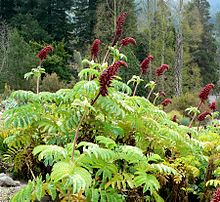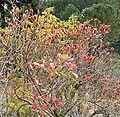Honey shrub plants
| Honey shrub plants | ||||||||||||
|---|---|---|---|---|---|---|---|---|---|---|---|---|

Melianthus comosus , zygomorphic flowers |
||||||||||||
| Systematics | ||||||||||||
|
||||||||||||
| Scientific name | ||||||||||||
| Melianthaceae | ||||||||||||
| Bercht. & J. Presl |
The honey shrub plants (Melianthaceae) are a plant family within the order of the cranesbill-like (Geraniales). The species are found exclusively in tropical to subtropical Africa .
description
Vegetative characteristics
They are mostly small trees , rarely bushes or herbaceous plants . The alternate , stalked leaves are simple or pinnate. The leaf margins are serrated or imperforate. The stomata are anomocytic. In Greyia , the leaf sheaths are fused with the branch. The two large, serrated stipules per leaf are often fused.
Generative characteristics
The flowers stand together in terminal, racemose inflorescences . In Bersama and Melianthus flowers are resupinated by turning the flower stalk . The relatively large, mostly hermaphrodite flowers are more or less strongly zygomorphic , five-fold with a double perianth . The five sepals are all free from each other or two of them are fused; there may be an appendage or spur at the base of Melianthus . There are four to five (to six) free, nailed petals available. There is only one circle with four or five fertile stamens (rarely two circles with a total of eight to ten stamens); they are not fused with the petals, but can be fused with each other at their base. The three-cell pollen grains have three apertures and are colporat. Nectar production takes place in a disc with individual or connected nectar glands. The usually four or five (three to seven) carpels are fused to form an upper, four- to five- chamber ovary. In Bersama there is only one anatropic, bitegmic, crassinucellate ovule per ovary chamber ; in Melianthus there are two to five per ovary chamber ; they are hanging to horizontal. A stylus stands in a depression in the ovary. Greyia and many species of Melianthus are pollinated by birds.
Loculicidal capsule fruits with a paper-like or woody wall are formed. When ripe they only open at their tip. The mostly oil-containing seeds contain a lot of endosperm , with or without starch. The small, chlorophyll-containing, straight embryo is well developed.
Ingredients and chromosome numbers
There are calcium oxalate crystals present. There may be strength. There is quercetin and ellagic acid .
The number of chromosomes is n = 18 or 19.

Systematics
In the family Melianthaceae only three genera with about eleven to fifteen species have been listed:
-
Bersama Fresen. , with two to four types:
- Bersama abyssinica Fresen. ; Home: Southeast Africa
- Bersama engleriana Gürke (also referred to as subsp. Paullinioides (Planch.) Verdc. = Subsp. Engleriana (Gürke) F. White to B. abyssinica ); Home: Mozambique, Zimbabwe
- Bersama swynnertonii Baker f. ; Home: Southeast Africa
- Bersama usambarica Gürke
-
Bottle brushes ( Greyia Hook. & Harv. ), With some authors a separate family Greyiaceae Hutch., With three types:
- Greyia flanaganii bolus ; Home: South Africa
- Transvaal bottle brush ( Greyia radlkoferi Szyszyl. ); Home: Eastern South Africa
- Greyia sutherlandii Hook. & Harv. ; Home: Eastern South Africa
-
Honey bushes ( Melianthus L. ), species (selection):
- Melianthus comosus Vahl (Syn .: Melianthus minor L.)
- Melianthus elongatus Wijnands (Syn .: Melianthus minor auct.)
- Honey bush ( Melianthus major L. )
According to APG III, the taxa of the previous Francoaceae family are added:
-
Francoa Cav. : With the single species (sometimes two or three species are given):
- Francoa sonchifolia ( Willd. ) Cav. (Syn .: Panke sonchifolia Willd. ): It is rich in shapes and thrives in the mountains of central Chile. It is called goose thistle-leaved Francoa or rarely bridal wreath and is occasionally used as an ornamental plant.
-
Tetilla DC. : With the only kind:
- Tetilla hydrocotylifolia DC. : It thrives in southern Chile.
use
Not much is known about human use. The flowers of Melianthus minor and Melianthus major are collected and eaten because of their high nectar content. The medicinal effects of Melianthus major have been studied. A dye is obtained from the flowers of Melianthus major .
Few species are used as ornamental plants.
photos
Melianthus major :
Greyia radlkoferi :
swell
- The family of Melianthaceae and the family of francoaceae in APWebsite. (Section description and systematics)
- The family of Melianthaceae and the family of francoaceae at DELTA L. Watson and MJ Dallwitz. (Section description)
- Keith Coates Palgrave: Trees of southern Africa. 5th edition. Struik Publishers, Cape Town 1988, ISBN 0-86977-081-0 .
Individual evidence
- ↑ Melianthaceae in the Germplasm Resources Information Network (GRIN), USDA , ARS , National Genetic Resources Program. National Germplasm Resources Laboratory, Beltsville, Maryland.
- ↑ Angiosperm Phylogeny Group : An update of the Angiosperm Phylogeny Group classification for the orders and families of flowering plants: APG III. In: Botanical Journal of the Linnean Society. Volume 161, No. 2, 2009, pp. 105-121, DOI: 10.1111 / j.1095-8339.2009.00996.x .
- ^ Melianthus minor at Plants For A Future and Melianthus major at Plants For A Future
Web links
- Entries to Melianthaceae at plants for a future (English)







